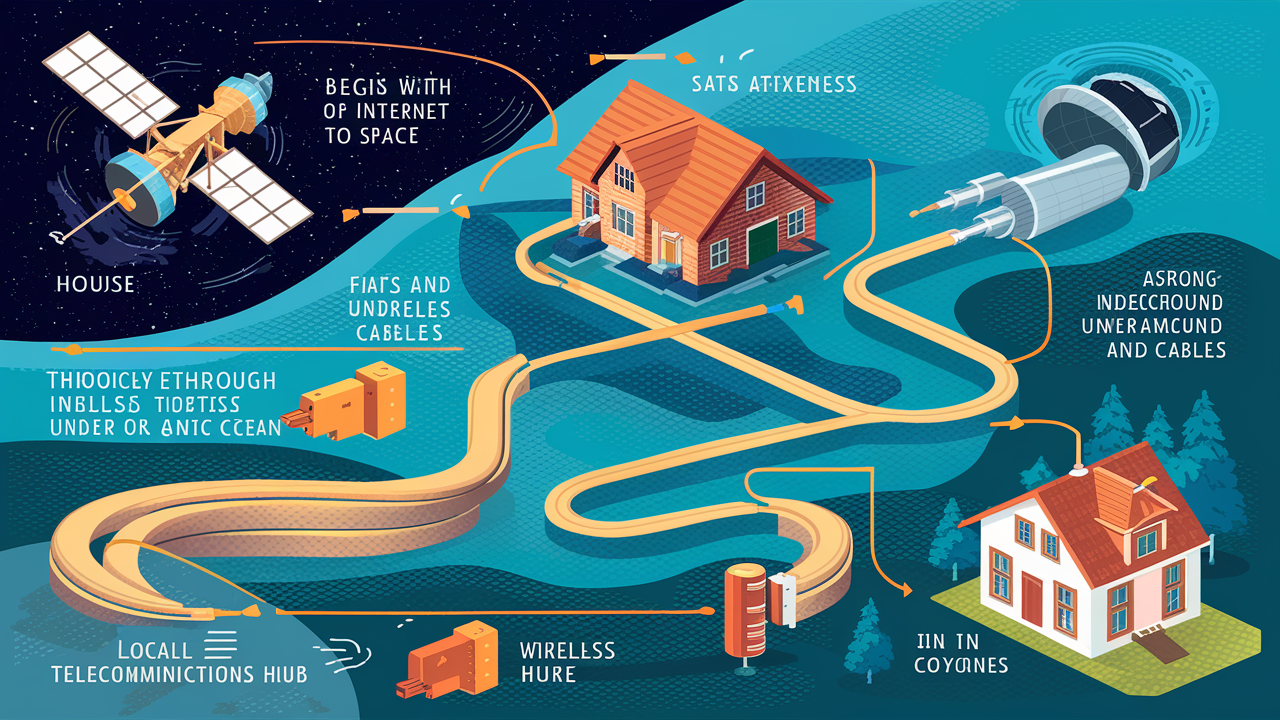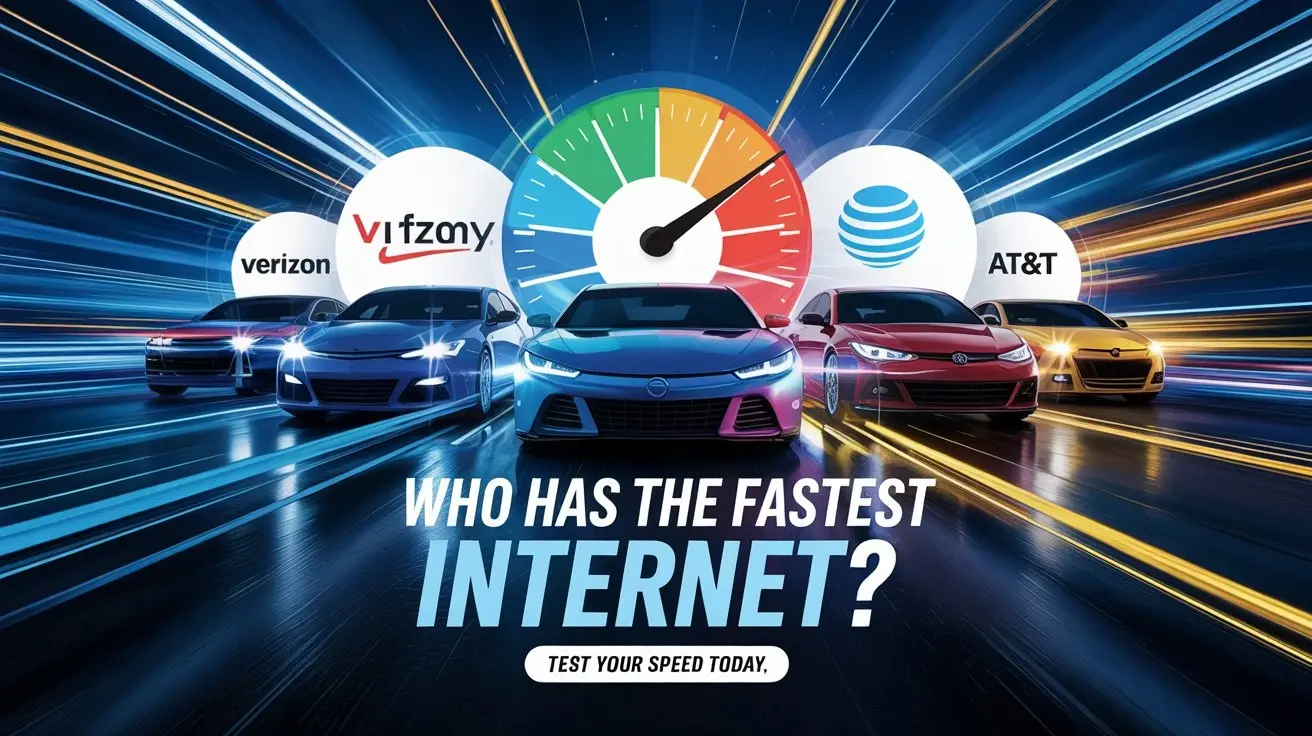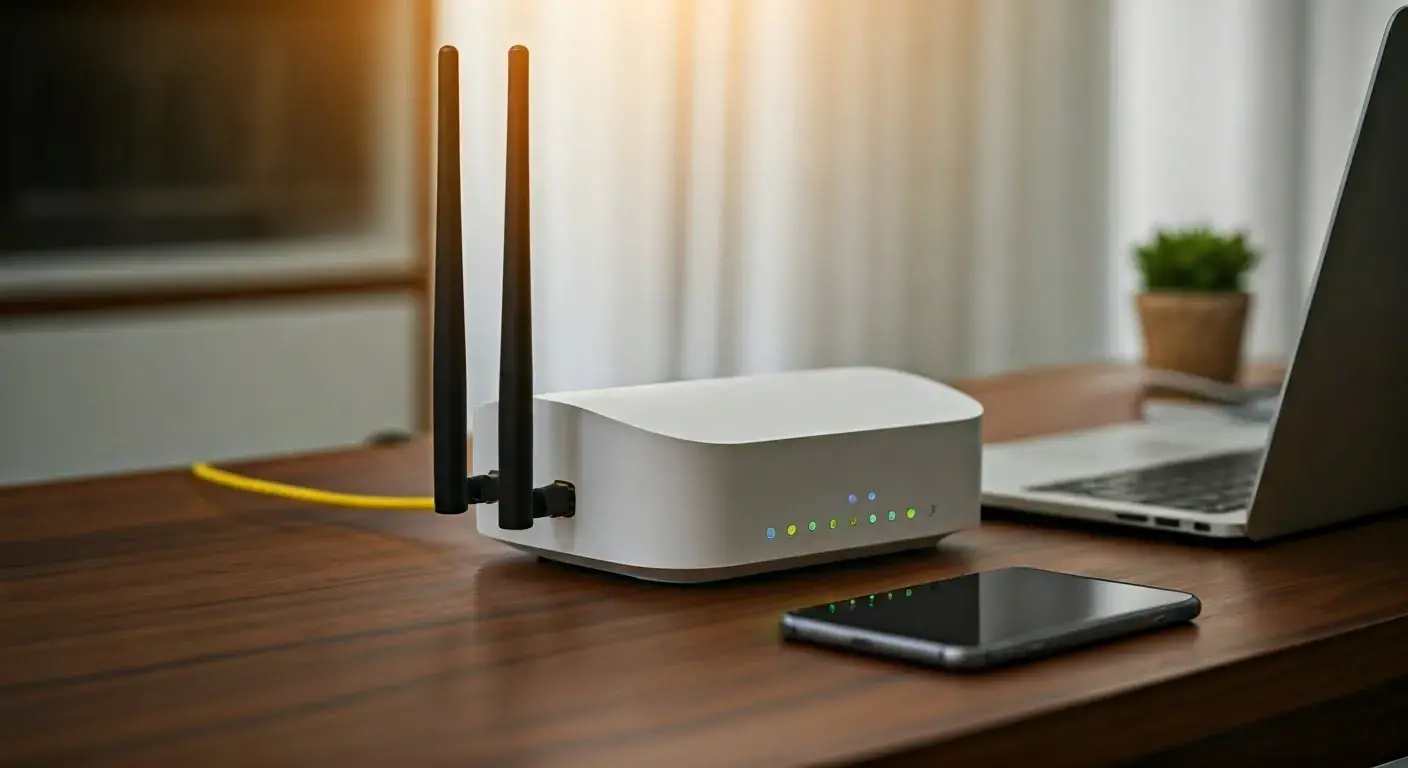How does my internet get to my house?

Ever wondered about the invisible journey your internet data takes to reach your home? This comprehensive guide demystifies the complex process, from global networks to your doorstep, explaining the technology and infrastructure that makes your online world possible. Discover the surprising steps involved in connecting you to the digital universe.
Understanding the Internet's Infrastructure
The internet, a vast and intricate web of interconnected networks, doesn't magically appear in your home. It's a marvel of engineering, relying on a sophisticated global infrastructure to deliver data from its source to your devices. Understanding this process requires looking beyond your Wi-Fi router and delving into the physical pathways that carry digital information across continents and oceans. In 2025, this infrastructure is more vital than ever, supporting everything from remote work and online education to streaming entertainment and the burgeoning Internet of Things (IoT).
The Global Backbone: Oceans of Data
At the highest level, the internet is a network of networks. These networks are interconnected through massive data centers and high-capacity fiber optic cables. These cables are the true highways of the internet, carrying the bulk of global internet traffic. They are laid across the ocean floor, connecting continents and major internet exchange points (IXPs). These IXPs are physical locations where different internet service providers (ISPs) connect their networks, allowing data to flow seamlessly between them. Without these undersea cables, the internet as we know it would cease to exist.
Undersea Cables: The Unsung Heroes
These aren't your average telephone wires. Submarine communications cables are robust, high-speed fiber optic cables designed to withstand immense pressure and the harsh marine environment. They are typically buried a meter or two beneath the seabed to protect them from anchors, fishing trawls, and natural disasters. The sheer volume of data transmitted through these cables is staggering. For instance, the Transatlantic network alone carries exabytes of data daily, a figure that continues to grow exponentially each year. Major cable systems like the SEA-ME-WE (South-East Asia - Middle East - Western Europe) or the Pacific Light Cable Network are critical arteries for global communication. The maintenance and repair of these cables are complex operations, often involving specialized ships and remotely operated vehicles (ROVs).
Data Centers: The Brains of the Operation
Interspersed throughout this global network are massive data centers. These are secure facilities that house thousands of servers, storage systems, and networking equipment. They are the central hubs where websites are hosted, cloud services operate, and data is processed and stored. When you access a website, your request travels through various networks to reach a data center where the website's files are stored. The data center then sends the requested information back to you. These facilities require enormous amounts of power and sophisticated cooling systems to operate efficiently. In 2025, the demand for data center capacity continues to surge, driven by cloud computing, artificial intelligence, and the ever-increasing volume of digital content.
Internet Exchange Points (IXPs): The Meeting Places
IXPs are critical infrastructure where different ISPs peer with each other. Instead of paying to send traffic across other networks, ISPs can directly exchange traffic at an IXP, reducing latency and costs. Think of them as major intersections where different highways meet. The more IXPs in a region, the more direct and efficient the data routes can be. Major IXPs are located in cities like London, Frankfurt, Amsterdam, New York, and Singapore, serving as crucial nodes in the global internet topology. These points are essential for maintaining the resilience and speed of the internet.
The Journey Begins: From Global Networks to Your Local Area
Once data leaves the global backbone, it begins its journey towards your local community. This involves a series of steps that bring the internet closer to your home, moving from vast international networks to regional and then local distribution points. The technology used at each stage is optimized for speed, capacity, and reliability, ensuring that your online experience is as seamless as possible.
Regional and Local Networks
ISPs operate their own regional networks that connect to the global backbone and IXPs. These networks consist of more fiber optic cables, routers, and switches that distribute internet traffic across geographical areas. As the data gets closer to your home, it enters the local distribution network managed by your ISP. This network is designed to handle the aggregate internet traffic of a specific town or city, preparing it for the final delivery to individual households.
The Role of Routers and Switches
Routers and switches are the traffic controllers of the internet. Routers direct data packets between different networks, determining the most efficient path for them to travel. Switches, on the other hand, manage traffic within a single network, ensuring data reaches the correct destination device. In the journey from global networks to your home, data passes through a multitude of these devices, each playing a crucial role in guiding the information accurately and swiftly. The sophistication of these devices, especially in 2025, allows for incredibly fast packet switching and routing, minimizing delays.
The ISP's Network Architecture
Your Internet Service Provider (ISP) is the company you pay for internet access. They own and operate the infrastructure that brings the internet to your neighborhood. This infrastructure includes the cables, routers, and other equipment that connect your home to their wider network. The ISP's network is typically a hierarchical structure, with large, high-capacity lines converging at central offices and then branching out into smaller distribution lines that serve individual neighborhoods and streets.
Central Offices and Distribution Hubs
Central offices, also known as Points of Presence (PoPs), are key facilities for ISPs. These are the points where the ISP's regional network connects to the wider internet and where local distribution networks originate. From these central offices, fiber optic cables or other transmission media are laid out to serve various areas. Distribution hubs within neighborhoods further break down this connectivity, preparing it for the final connection to individual homes. The density and capacity of these hubs are crucial for providing high-speed internet to a growing number of users.
The Crucial Last Mile: Connecting Your Home
The "last mile" is arguably the most critical and often the most challenging part of delivering internet to your house. This refers to the final segment of the network that connects the ISP's distribution point to your actual residence. The technology used for the last mile significantly impacts your internet speed, reliability, and cost. In 2025, advancements in last-mile technologies are continuously pushing the boundaries of what's possible, but legacy infrastructure still plays a significant role.
Physical Pathways: Cables and Wires
The physical infrastructure that forms the last mile can vary greatly. It's the tangible connection that brings the digital world into your home. This can include a variety of technologies, each with its own advantages and limitations.
Fiber Optic Cables (FTTH/FTTP)
Fiber-to-the-Home (FTTH) or Fiber-to-the-Premises (FTTP) is the gold standard for internet connectivity. In this setup, a pure fiber optic cable runs directly from the ISP's central office or distribution hub all the way to your house. Fiber optics transmit data using light pulses, which allows for incredibly high speeds, low latency, and immunity to electromagnetic interference. Speeds of 1 Gbps and even 10 Gbps are becoming increasingly common with fiber. The deployment of fiber, however, can be expensive and time-consuming, requiring significant trenching and installation work.
Coaxial Cables (Cable Internet)
Cable internet uses the same coaxial cables that deliver cable television to your home. These cables are capable of carrying both TV signals and internet data. The data travels as electrical signals over copper wires. While cable internet can offer high speeds, especially with DOCSIS 3.1 and newer standards (like DOCSIS 4.0, which is gaining traction in 2025), its performance can be affected by the number of users sharing the same network segment. Speeds can vary, but 100 Mbps to 1 Gbps are typical for many plans. The infrastructure is already in place for many homes, making it a widely available option.
Copper Wires (DSL)
Digital Subscriber Line (DSL) internet uses existing telephone lines (copper wires) to transmit data. DSL modems modulate and demodulate signals to carry digital data over analog phone lines. The speed of DSL is highly dependent on the distance from your home to the ISP's central office or local exchange. The further away you are, the slower the connection will be. While DSL was once the primary method for home internet, it has largely been surpassed by cable and fiber in terms of speed and performance. However, it remains a viable option in areas where other technologies are not yet available. Speeds typically range from a few Mbps to around 100 Mbps in its faster iterations (like VDSL).
Wireless Connections: The Airwaves
While wired connections are prevalent, wireless technologies also play a significant role in last-mile connectivity, especially in rural or hard-to-reach areas.
Fixed Wireless Access (FWA)
Fixed Wireless Access uses radio waves to connect a home to a nearby ISP tower or access point. A small antenna is installed on your house, which communicates wirelessly with the ISP's equipment. FWA can be a good alternative to wired connections when trenching is not feasible or cost-effective. Speeds can vary widely depending on the technology used and the line of sight to the tower, with some FWA services in 2025 offering speeds comparable to cable or even entry-level fiber. It's a rapidly evolving technology, with 5G FWA becoming increasingly common.
Satellite Internet
Satellite internet provides a connection by beaming data to and from a satellite orbiting Earth. This is often the only option for very remote locations where no terrestrial infrastructure exists. However, satellite internet is typically characterized by higher latency (due to the long distance the signal travels), lower speeds, and data caps compared to other technologies. Despite these drawbacks, satellite technology is improving, with newer constellations like Starlink aiming to offer more competitive speeds and lower latency in 2025.
Types of Internet Connections to Your House
The variety of ways internet reaches your home can be confusing. Each type of connection utilizes different technologies and infrastructure, leading to distinct performance characteristics. Understanding these differences is key to choosing the best option for your needs and location. Here's a breakdown of the most common types of internet connections in 2025, along with their pros and cons.
Comparison of Last-Mile Technologies
To help illustrate the differences, let's look at a comparative table:
| Technology | Primary Medium | Typical Download Speeds (2025) | Typical Upload Speeds (2025) | Latency | Availability |
|---|---|---|---|---|---|
| Fiber Optic (FTTH) | Fiber Optic Cable | 100 Mbps - 10 Gbps+ | 100 Mbps - 10 Gbps+ | Very Low (1-10 ms) | Growing, but not universal |
| Cable Internet | Coaxial Cable | 50 Mbps - 1 Gbps+ | 5 Mbps - 100 Mbps+ | Low (10-30 ms) | Widely available in urban/suburban areas |
| DSL (VDSL) | Copper Phone Line | 25 Mbps - 100 Mbps | 1 Mbps - 20 Mbps | Moderate (20-80 ms) | Widely available, but speeds decrease with distance |
| Fixed Wireless Access (FWA) | Radio Waves | 50 Mbps - 1 Gbps+ (with 5G) | 10 Mbps - 100 Mbps+ (with 5G) | Low to Moderate (20-60 ms) | Growing, especially in underserved areas |
| Satellite Internet | Satellite Dish | 25 Mbps - 150 Mbps (variable) | 3 Mbps - 20 Mbps (variable) | High (400-700 ms) | Available almost anywhere with a clear sky view |
Fiber Optic: The Pinnacle of Speed
Fiber optic internet is the most advanced technology currently available for home use. It utilizes thin strands of glass or plastic to transmit data as pulses of light. This method offers unparalleled speed, bandwidth, and reliability. Because light is not susceptible to electromagnetic interference, fiber connections are very stable. Furthermore, the speeds are symmetrical, meaning download and upload speeds are often identical, which is crucial for video conferencing, online gaming, and uploading large files. The primary challenge with fiber is its deployment, which requires significant infrastructure investment. However, in 2025, many ISPs are aggressively expanding their fiber networks to meet the growing demand for high-speed internet.
Cable Internet: A Widely Available Powerhouse
Cable internet has been a staple for many households for years, leveraging the existing coaxial cable network used for cable television. It uses radio frequency signals to transmit data over copper cables. Modern cable internet, particularly with DOCSIS 3.1 and the emerging DOCSIS 4.0 standards, can deliver very respectable speeds, often rivaling or exceeding DSL and even some fiber offerings in download capacity. However, upload speeds are typically much lower than download speeds, as the network architecture is designed for one-way content delivery. A key consideration is that cable internet is a shared medium; the bandwidth is distributed among users in a neighborhood, so speeds can sometimes fluctuate during peak usage times.
DSL: The Persistent Performer
DSL internet technology has been around for decades, utilizing the copper telephone lines that are present in most homes. It works by using a wider range of frequencies than traditional voice calls, allowing for simultaneous internet and phone use. The speed of DSL is directly related to the distance between your home and the ISP's local exchange or central office. The closer you are, the faster your connection. While standard DSL speeds are modest, newer variants like VDSL (Very High-Speed DSL) can offer significantly improved performance, sometimes reaching speeds comparable to entry-level cable plans. DSL is often the most accessible option in rural areas where fiber or advanced cable networks haven't been deployed.
Fixed Wireless Access: Bridging the Gap
Fixed Wireless Access (FWA) has emerged as a strong contender, especially for areas where laying physical cables is difficult or expensive. It involves a directional antenna installed at your home that communicates with a nearby tower or access point operated by the ISP. The "wireless" aspect is only for the last mile; the ISP's tower is connected to the wider internet via high-capacity fiber. With the rollout of 5G technology, FWA services are offering increasingly competitive speeds and lower latency, making them a viable alternative to wired connections for many users. It's particularly beneficial for suburban and rural communities looking for faster internet without the cost of extensive cable deployment.
Satellite Internet: Reaching the Unreachable
For the most remote locations, satellite internet remains the primary, and sometimes only, option. It involves a satellite dish at your home that communicates with satellites in orbit. These satellites then relay the data to ground stations, which are connected to the internet. While satellite technology has improved, it still faces challenges with latency due to the vast distances involved, and speeds can be inconsistent. However, new satellite constellations, such as SpaceX's Starlink, are aiming to revolutionize satellite internet by using large numbers of low-Earth orbit (LEO) satellites to provide higher speeds and significantly reduced latency, making it a more attractive option in 2025 for those in underserved regions.
How It All Comes Together: The Final Steps
Once the internet data has traversed the global networks, regional infrastructure, and the last mile, it arrives at your home. The final stages involve translating this incoming data into a format your devices can understand and then distributing it throughout your house. This process is managed by your modem, router, and Wi-Fi network.
The Modem: The Translator
Your modem is the device that bridges the gap between your ISP's network and your home network. It stands for "modulator-demodulator." Its primary function is to translate the incoming signals from your ISP (which can be light pulses for fiber, electrical signals for cable, or radio waves for wireless) into digital data that your computer and other devices can process. Conversely, when you send data out, the modem converts your digital data back into a format that can be transmitted over the ISP's network. The type of modem you need depends on your internet connection type (e.g., a cable modem for cable internet, a DSL modem for DSL, or an optical network terminal (ONT) for fiber).
Modem Types and Functions
Each type of modem is specifically designed for its corresponding transmission medium:
- Cable Modems: Connect via coaxial cable and translate RF signals into digital data.
- DSL Modems: Connect via telephone lines and translate analog phone signals into digital data.
- Optical Network Terminals (ONTs): For fiber optic internet, an ONT is used to convert light signals from the fiber optic cable into electrical signals that your home network can use.
- Fixed Wireless Modems/Receivers: These devices receive radio signals from the ISP's tower and convert them into a usable digital format.
- Satellite Modems: These are integrated into the satellite dish system and manage the communication with the satellite.
The Router: The Traffic Director Within Your Home
While the modem handles the connection to the outside world, the router manages the traffic within your home network. A router has two main jobs: it connects all your devices (computers, smartphones, smart TVs, etc.) to each other and to the modem, and it directs internet traffic between these devices and the internet. When you have multiple devices connected, the router assigns each one a unique local IP address, allowing it to send and receive data independently. In 2025, most home routers are wireless routers, meaning they also broadcast a Wi-Fi signal.
Wi-Fi: Wireless Freedom
The Wi-Fi capability of your router allows your devices to connect to the internet wirelessly. The router broadcasts a radio signal that your devices can pick up. This eliminates the need for a physical Ethernet cable connection to every device. Wi-Fi standards, like Wi-Fi 6 (802.11ax) and the emerging Wi-Fi 7, are constantly evolving to provide faster speeds, greater capacity, and improved reliability, especially in homes with many connected devices. The range and strength of your Wi-Fi signal can be affected by factors like the size of your home, building materials, and interference from other electronic devices.
Connecting Your Devices
Once the data reaches your router, it's then delivered to your specific device. If the device is connected via an Ethernet cable, the router sends the data directly through the cable. If the device is connected via Wi-Fi, the router transmits the data wirelessly. Your device then receives the data, and its operating system processes it, displaying web pages, playing videos, or running applications. This entire process, from a server on the other side of the world to your screen, happens in fractions of a second thanks to the advanced networking technologies in place in 2025.
IP Addresses: Your Device's Identity
Every device connected to the internet needs an address to send and receive data. This is known as an Internet Protocol (IP) address. Your modem receives a public IP address from your ISP, which identifies your home network on the internet. Your router then assigns private IP addresses to each device within your home network. When data comes from the internet, the router uses the public IP address to receive it and then directs it to the correct private IP address of the device that requested it.
The Future of Internet Connectivity
The internet is not a static entity; it's constantly evolving. Innovations in technology and infrastructure are continually pushing the boundaries of speed, accessibility, and reliability. As we look ahead, several key trends are shaping the future of how internet gets to your house.
Advancements in Fiber Deployment
Fiber optic technology is expected to continue its expansion, becoming the dominant last-mile solution in many areas. Governments and ISPs are investing heavily in fiber rollouts to ensure widespread access to high-speed internet. Future advancements will focus on increasing the capacity of fiber cables and developing even more efficient deployment methods. The goal is to make gigabit speeds the standard for most households.
The Rise of 5G and Beyond
5G wireless technology is already transforming fixed wireless access, offering speeds and latency that rival wired connections. As 5G networks mature and become more widespread, FWA will become an even more compelling option, especially in areas where traditional infrastructure is lacking. Looking further ahead, research into 6G and other advanced wireless technologies promises even greater capabilities, potentially blurring the lines between wired and wireless connectivity.
Satellite Constellations and Global Access
The development of large satellite constellations, like Starlink and OneWeb, is set to dramatically improve internet access in remote and rural areas. By deploying thousands of small satellites in low Earth orbit, these systems can provide higher speeds and lower latency than traditional geostationary satellites. This will bring reliable internet to regions previously underserved by terrestrial networks, democratizing access to online resources and opportunities.
Smart Infrastructure and AI
The future internet infrastructure will be smarter and more adaptive. AI and machine learning will play a larger role in optimizing network performance, predicting and preventing outages, and managing traffic flow more efficiently. This will lead to a more resilient, faster, and personalized internet experience for users. Network management systems will become more sophisticated, capable of dynamically allocating resources to meet demand.
Increased Bandwidth Demands
The ever-increasing demand for bandwidth, driven by high-definition streaming, virtual reality, augmented reality, and the growing number of connected devices, will continue to push technological innovation. ISPs and equipment manufacturers will need to constantly upgrade their infrastructure to keep pace. The concept of "bandwidth scarcity" may become a thing of the past as new technologies unlock unprecedented data transfer capabilities.
Understanding how your internet gets to your house reveals a complex, yet elegant, system. From the vast global fiber optic cables traversing oceans to the local distribution networks and the final connection to your home, each step is crucial. Whether you have fiber, cable, DSL, or a wireless connection, the underlying principle is the same: data travels through a series of physical pathways and electronic devices to reach your devices. As technology advances, the speed, reliability, and accessibility of internet connectivity will continue to improve, further integrating the digital world into our daily lives. Stay informed about the options available in your area and consider upgrading to a faster, more reliable connection to fully benefit from the digital age.





